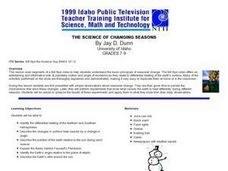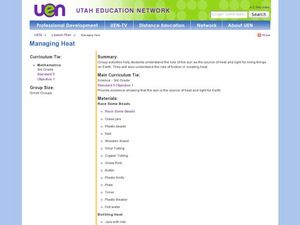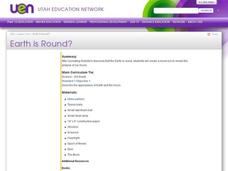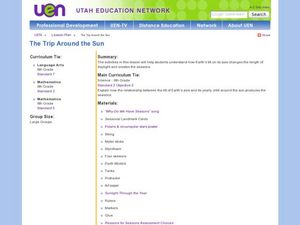THNKR
Bill Nye: Is Jupiter Like A Piece Of The Sun?
Jupiter and the sun are more alike than you might think. Examine the elements that make up these two heavenly bodies as part of the Fuse THNKR "Why with Nye!" playlist. Bill Nye explains the composition of the sun and Jupiter, then...
Bill Nye
Bill Nye The Science Guy on Outerspace
Give your gang a visual of scale, or help them to comprehend distances in space with this Bill Nye video. In it, he arranges a series of balls along the length of a soccer field using correct proportional distances from a soccer-ball...
THNKR
Bill Nye Explains the Earth Fly By
How do we learn more about the planets in our solar system? Bill Nye discusses the Juno space probe during an interesting video as part of the THNKR Why with Nye! playlist. Topics include how scientists launched the probe, how NASA used...
Bill Nye
Bill Nye The Science Guy on The Sun
This flick opens by revealing the enormity and extreme heat of the sun through a very old-fashioned cartoon. A solar eclipse is explained by Mr. Nye, and a safe way to examine an image of the sun is demonstrated. That's the extent of...
THNKR
Bill Nye's Solar Powered Spacecraft
It keeps going, and going, and going ... how does the Juno space probe have enough power to travel to Jupiter? Junior astronauts use a THNKR "Why with Nye!" video to discover solar-powered science with the one and only Bill Nye. Topics...
THNKR
Bill Nye Searches For Water On Jupiter
How can researchers measure the amount of water on Jupiter? Through a thought-provoking THNKR "Why with Nye!" video, young space scientists search for the universal solvent on a distant planet. Topics include how scientists use visible...
Bill Nye
Bill Nye The Science Guy on Wind
Heating and spinning of our planet are what generate wind. A very large tank is used to model the phenomenon of convection, which is explained by Bill, but never specifically mentioned. If you show this mini movie to your meteorology...
Bill Nye
Bill Nye The Science Guy on Ocean Currents
Density drives the ocean currents. The difference in density is caused by the sun heating up the water and causing evaporation that leaves salt behind. The result? Thermohaline circulation! You could highlight this fine film in your...
Bill Nye
Bill Nye The Science Guy on Planets and Moons
Why is a Neptune year longer than a Mercury year? Planetary orbits are compared as Bill Nye The Science Guy swings a tether ball around his head. He reveals that increasing distances from the sun make the journeys around it longer....
TED-Ed
Sending a Sundial to Mars
You know him from his famous science education videos, but now hear him get personal as he tells the story of how his father, while being a prisoner of war, became fascinated with sundials. Today, he has inherited the fascination, and in...
Curated OER
The Science of Changing Seasons
Students explore basic principles of seasonal change, ponder the mechanisms that drive these changes, and perform experiments that show what causes the earth to heat differently during different seasons.
Curated OER
Around the Sun We Go
Sixth graders complete a short survey on the relationship between the Earth and the Sun. In groups, they participate in an experiment in which they test the angle of the Earth and compare it to the sun. To end the lesson plan, they...
Curated OER
Bill Nye- The Atmosphere
In this science worksheet, middle schoolers look for the words that fill the blanks to cover the concept of the atmosphere. The activity is meant to be a review.
Curated OER
Managing Heat
Third graders perform various experiments to show the flow of energy that causes heat. In this heat lesson, 3rd graders understand how heat is transferred or trapped. Students use the scientific method and critical thinking skills to...
Curated OER
Earth is Round?
Third graders discuss how Aristotle concluded that the Earth was round. As a class, they review theories about the Earth's shape and describe how life on Earth would be different if it were flat. Individually, they make a moon book in...
Curated OER
The Trip Around the Sun
Sixth graders investigate the relationship between the tilt of the Earth's axis and the seasons. In this earth science lesson plan, 6th graders sing the song "Why Do We Have Seasons" and use simulate the Earth's tilt by using their bodies.
Curated OER
Distance in Space
Sixth graders explore space science by measuring distances between planets. In this solar system lesson, 6th graders view a Bill Nye video and discover the conversion between the metric system and imperial measuring systems. Students...
Curated OER
Catching Some Rays
Sixth graders explore the tilt of Earth's axis. In this Earth lesson plan, 6th graders read a Greek mythology story explaining why there are seasons. Students build a sun-ray gathering tool from styrofoam, glue, thermometers, skewers,...
National Renewable Energy Laboratory
No Fossils in This Fuel
Yeast and sugar go beyond the pantry and into a fuel experiment. Use these common baking ingredients to assist your class in creating ethanol, a natural fuel. Pupils observe the process and gather information to elaborate on the...
Curated OER
Got Plants
Second graders discover that all living things need food in order to live. In groups, they examine the interconnectedness between animals and plants. They identify which animals eat plants to survive and which animals eat animals that...
Curated OER
Investigation 3 - Weathering
Fourth graders study 4 types of weather processes: wind, running water, plant growth, and freezing water. They explain how the processes of weathering and erosion change and move materials that become soil. They draw diagrams...
Curated OER
Celebrate The Four Seasons
Students investigate cause and effect and compare and contrast how recurring cycles are evident in multiple aspects of their education. They answer questions in the chosen field. Students model each aspect by interpreting, perceiving and...























